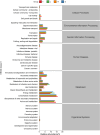Community structure of habitat microorganisms and endophytes of narrow-ranged species Corybas fanjingshanensis at different ecological niche specificities
- PMID: 40739611
- PMCID: PMC12312428
- DOI: 10.1186/s12870-025-07046-z
Community structure of habitat microorganisms and endophytes of narrow-ranged species Corybas fanjingshanensis at different ecological niche specificities
Abstract
Background : C. Fanjingshanensis is an extremely narrow-range species endemic to Mount Fanjing, the main peak of the Wuling Mountains in China. It has a highly restricted distribution and limited population size, grows primarily in mosses within alpine dwarf forests, and is highly sensitive to environmental changes, facing a high risk of extinction. Artificially assisted conservation is essential to maintaining its population. To ensure the success of future biodiversity conservation strategies such as ex situ conservation and habitat restoration, we used high-throughput sequencing to profile endophytes within C. fanjingshanensis tissues and microbial communities inhabiting its moss substrate and associated water layer. We analyzed the characteristics of both endophytic and habitat-associated microbiota and their relationships, providing a basis for optimizing microbial-assisted artificial habitat simulation.
Results: We identified 177 core bacterial and 37 core fungal genera in the moss layer, and 87 bacterial and 50 fungal genera in the moss water layer. More beneficial bacteria and pathogenic fungi were enriched in moss water, whereas the moss layer exhibited a more complex and positively associated microbial network. The endophytic bacteria belonged to 42 phyla and 1,198 genera, showing significant differences in dominant genera and community diversity among root, stem, leaf, and tuber. In contrast, endophytic fungi belonged to 16 phyla and 943 genera, but their diversity remained relatively stable across tissues. The dominant shared core endophytic bacterial and fungal genera were primarily derived from the dominant microbial genera in the moss water layer.
Conclusion: There were substantial differences in habitat microbial community. More beneficial bacteria and pathogenic fungi were enriched in the moss water layer. The moss layer exhibited a well-structured, positively associated microbial community, which may facilitate resistance to environmental stress. Among tissues, tubers harbored significantly higher diversity and richness of endophytic bacteria compared to other tissues. Endophytic fungal diversity and community structure remained relatively stable. Moss water microbes were an important source of endophytes. This study provides a reference for the development of artificially assisted conservation strategies for alpine narrow-range species represented by C. fanjingshanensis.
Supplementary Information: The online version contains supplementary material available at 10.1186/s12870-025-07046-z.
Keywords: Corybas; Core microorganism; Endophytes; Habitat microbes; Micro-niche; Orchid.
Conflict of interest statement
Declarations. Ethics approval and consent to participate: Not applicable. Consent for publication: All plant material in this article was collected with official permission and in the company of management staff. Competing interests: The authors declare no competing interests.
Figures









Similar articles
-
Conservation genetics and potential geographic distribution modeling of Corybas taliensis, a small 'sky Island' orchid species in China.BMC Plant Biol. 2024 Jan 2;24(1):11. doi: 10.1186/s12870-023-04693-y. BMC Plant Biol. 2024. PMID: 38163918 Free PMC article.
-
Microsatellite markers for Corybas (Orchidaceae) species in New Zealand.Appl Plant Sci. 2018 Nov 9;6(11):e01192. doi: 10.1002/aps3.1192. eCollection 2018 Nov. Appl Plant Sci. 2018. PMID: 30473938 Free PMC article.
-
Leaf Health Status Regulates Endophytic Microbial Community Structure, Network Complexity, and Assembly Processes in the Leaves of the Rare and Endangered Plant Species Abies fanjingshanensis.Microorganisms. 2024 Jun 21;12(7):1254. doi: 10.3390/microorganisms12071254. Microorganisms. 2024. PMID: 39065023 Free PMC article.
-
The Waiting Room Hypothesis revisited by orchids: were orchid mycorrhizal fungi recruited among root endophytes?Ann Bot. 2022 Feb 11;129(3):259-270. doi: 10.1093/aob/mcab134. Ann Bot. 2022. PMID: 34718377 Free PMC article. Review.
-
Unlocking the metabolic potential of endophytic fungi through epigenetics: a paradigm shift for natural product discovery and plant-microbe interactions.Nat Prod Rep. 2025 Jul 28. doi: 10.1039/d5np00028a. Online ahead of print. Nat Prod Rep. 2025. PMID: 40719258 Review.
References
-
- Herrera H, Inmaculada GR, Meneses C, Pereira G, Arriagada C. Orchid mycorrhizal interactions on the Pacific side of the Andes from Chile. A review. J Soil Sci Plant Nutr. 2019;19:187–202. 10.1007/s42729-019-00026-x.
-
- Chengru L, Na D, Yamei Z, Shasha W, Zhongjian L, Junwen Z. A review for the breeding of orchids: current achievements and prospects. Hortic Plant J. 2021;7:380–92. 10.1016/j.hpj.2021.02.006.
-
- Tiiu K, Michael JH. A comparative analysis of decline in the distribution ranges of Orchid species in Estonia and the united Kingdom. Biol Conserv. 2006;129:31–9. 10.1016/j.biocon.2005.09.046.
-
- Chase MW, Cameron KM, Freudenstein JV, Pridgeon AM, Schuiteman A. An updated classification of Orchidaceae. Bot J Linn Soc. 2015. 10.1111/boj.12234.
Grants and funding
LinkOut - more resources
Full Text Sources

